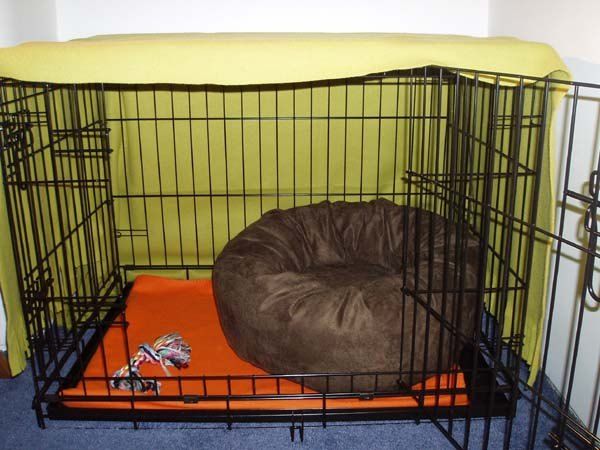|
|
Location: South Africa, Northwold, JHB
Joined: Jan 2005
Posts: 1,307
|
07-03-2005, 11:00 AM

|
|
|
Joined: Feb 2005
Posts: 4,638
|
09-03-2005, 10:51 AM
Here's a pic (also posted elsewhere) of his little 'home'.... I really don't see how this is cruel LOL

Edited to ad pic.... DUH!!

|
|
|
Location: Greater London
Joined: Mar 2005
Posts: 339
|
09-03-2005, 12:03 PM
Probably the best invention in the last 25 years for dogs.
This is a little article that I give my clients on Introducing a crate.
Introducing a Crate to a Dog
Dogs have a natural liking for enclosed sleeping places - think of how often your dog chooses to sleep under the table, against a wall or behind the settee! Although their resemblance to cages or prison puts many people off using crates, if they are properly introduced and used they can be a helpful aid to training.
Once your dog is happy in the crate he can be left there to prevent soiling and chewing when you are out for a short time, he can be restrained when the kids play noisy, energetic games which are not improved by his joining in, and he has a secure familiar bed which can be taken in the car and on holiday if needed.
A dog which is thrust unprepared into a crate and left is going to associate the crate with a most unpleasant experience and be very unhappy. A dog which is carefully introduced to a crate usually finds it a pleasant and secure place to be, so it is worth spending some time over the introduction process.
HOW TO CRATE TRAIN YOUR DOG
The crate should be big enough for your dog to stand up, turn round and stretch out when lying down. If he is a puppy, allow for growth. Cover the crate with a blanket or sheet so it is dark, den like and cosy.
To begin with you will need to leave the crate set up all the time. Later you may prefer not to, and some crates fold flat for easy storage when not in use.
When left in the crate your dog should have a toy or chew bone to keep him occupied when awake, soft bedding to sleep on, I prefer Vet Bed or the equivalent and a drink of water. Get a coop cup it clips or screws on the inside of the crate then you dont get spills.
Initially feed the dog in the crate every day, with the door open. This is an easy way to get him to like it!
Set the crate up in a quiet corner, and put the dog's bed into it. At this stage, leave the door pinned open so that the dog is never fastened in by mistake and never gets stressed.
Soon the dog should happily use the crate voluntarily. When you reach this stage, (NOT BEFORE) wait until he goes in for a sleep, then close the door. Stay in the room, and let him out as he starts to wake up.
When your dog is used to this routine, leave him for a minute after he wakes up, with you still in the room. Gradually (over about a week) increase the time you can do this. If your dog gets distressed, reassure him briefly but firmly and shorten the time on the next attempt. Don't make a big fuss - sweet nothings and lots of attention can make him think you're praising him for being distressed, and he'll do it all the more. Aim for the "nursing sister" approach when she comes to give you a big injection, sympathetic but business like!
When you can leave the dog like this, leave the room for a few minutes but stay in the house. Again, gradually increase the time you are out of sight till you can put the dog into his crate when you go shopping.
Your dog should never be left in a crate for more than 3 or 4 of hours. Except overnight.
Stan

|
|
|
Joined: Jan 2005
Posts: 989
|
09-03-2005, 02:06 PM
If used properly I think crates are fantastic!
I always have crates available when Im selling pups and most new owners buy one to take home with them, saves them money as well cos I buy in bulk so they are about half the cost of the ones you see in pet shops etc.

|
 |
«
Previous Thread
|
Next Thread
»
| Currently Active Users Viewing This Thread: 1 (0 members and 1 guests) | |
|
|
 Similar Threads
Similar Threads
|
||||
| Thread | Thread Starter | Forum | Replies | Last Post |
| feel like crying!!!! | Jenny234 | General Dog Chat | 45 | 12-01-2005 08:11 PM |
| Car crates | Lel | General Dog Chat | 6 | 11-10-2004 09:49 AM |










